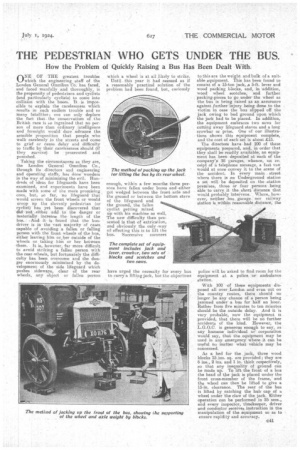THE PEDESTRIAN WHO GETS UNDER TnE BUS.
Page 29

If you've noticed an error in this article please click here to report it so we can fix it.
How the Problem of Quickly Raising a Bus Has Been Dealt With.
OCalaTE OF • THE greatest troubles which the engineering •ataff of the London General Omnibus Co. has faced, and faced manfully and thoroughly, is the propensity,of pedestrians, and cyclists (and particularly cyclists) to come into collision with the buses. It •is impossible to explain the carelessness which results in such endless trouble and so many fatalities; one can only deplore the fact that the conservatism Of the British race is so ingrained that no person of more than ordinary intelligence and foresight would dare advance the sensible proposition that people who walk carelessly in the streets and come to grief or cause delay and difficulty to traffic by their carelessness should (if they survive) be prosecuted and punished.
Taking the circumstances as they are, the London General Omnibus Co., through ita . directors and engineering and operating staffs, has done wonders in the way of minimizing the evil. Handrede of ideas for lifeguards have been examined, and experiments have been made with some of the mote promising ones, but, so far, no lifeguard that would screen the front wheels or would scoop up the slovenly pedestrian (or cycliat) has yet been discovered that 4.ift liataeither •add 'to the danger or materially increase the.• length of the bus. ,And' it is found that the bus. driveris in the vast majority of cases capable of •avoicling a fallen or falling person with the hunt wheels of the bus, either leaving him other Outside of the wheels or taking • him or her between .them. • It is,. however, far more difficult to avoid striking a fallen person. with the rear wheels, but fortunately the difficulty has been overcome and the danger enormously minimized by the development of the side lifeguard which pushes sideways, clear of the rear wheels, any object or fallen person
which a wheel is at all likely to strike. Until • this year it had seemed as if a reasonably practical solution of the problem had been found, but, curiously
enough, within a few months three persons have fallen under buses and either got wedged between the front axle and the ground or between the bottom stave of the lifeguard and the ground, the fallen cycliat getting mixed up with his machine as well. The new difficulty then presented is that of extrication, and obviously the only -way of effecting this is to lift the bus. Successive coroners
have urged the necessity for every bus to carry a lifting jack, but the objections to this are the weight and bulk of a suitable equipment. This has been found to consist of a 15-ton jack, .a 5-ft. lever and wood packing blocks, and, in 'addition, wood wheel scotches, and further packing-pieces to go under the wheel as the bus is being raised as an assurance against farther injury being done to the viotim in case the bus slipped, off the jack owing to bad ground upon which the jack had to be placed. In addition, the equipment embraces two saws for cutting away lifeguard staves and a long crowbar or prise. One of our illustrations shows this equipment complete, and the cast of each set is about £15.
The directors have had 100 of these equipments prepared, and, in order that they shall be readily available, an equipment has been deposited at each of the eompany'ia 38 garages, whence, on re-. ceipt of a telephone message, a fast van would at once convey it to the scene of the aceident. In every main . street where there is an Undergroand station a set will he deposited on the .station premises, three or four persons being able 'to carry it the short distance that would probably, intervene. Where, however, neither . bus garage nor railway station is within reasonable distance, the
police will be asked to find room for the equipment at a police or ambulance station.
With 100 of these equipments disposed all over London and even out on the country routes, there should no longer be any chance of a person being . jammed under a bus for half an hour. Rather from five minutes to ten minutes should be the outside delay. And it -is very probable, now the equipment is provided, that there will be no further accidents of the kind. However, the L.G.O.C. is generous enough to say, as any humane individual or corporation would say, that the equipment may be used in any emergency where it can be useful no matter what vehicle may be concerned.
As a bed for the ajack, three wood blocks 15 ins. sq. are provided; they are 6 ins., 2 ins. and 1 in. thick respectively, so that any inequality of ground can be made up. To lift the front of a bus the head of the jack is placed under the front cross-member of the frame,and the wheel can then be lifted to give a 15-in. clearance. The rear of the bus is lifted by catching the hub cap of a wheel under the claw of the jack. Either operation can be performed in 25 sees., and every inspector, timekeeper, driver and conductor receives instruction in the manipulation of the equipment so as to ensure rapidity and accuracy.














































